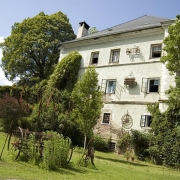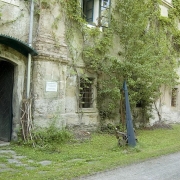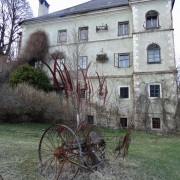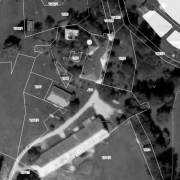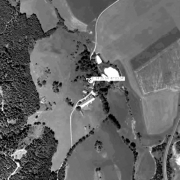Satellite Camp Schloss Lind
Establishment of the satellite camp
On 22 June 1942, 20 prisoners arrived at Lind Castle, adding to the approx. 50 Russian and several French prisoners of war that were already detained there. On 20 November 1942, the camp was incorporated into the Mauthausen system. The prisoners were used for work in agriculture and forestry.
Location
Lind Castle Subcamp in the town of St. Marein near Neumarkt, below Perachauer Sattel, was located on the premises of the castle, which served as an agricultural estate. With up to 30 prisoners, it was occasionally the smallest subcamp to Mauthausen Concentration Camp. The prisoners stayed in a room on the third floor of the small castle. What was unusual was that the storage rooms of the estate housed the living and working quarters of the owners, the POWs camp, and the living quarters of the SS, all in the same place as the concentration camp. The segregated places of power and authority that was usually common, did not exist in this camp.
Prisoners
On 22 June 1942, 20 prisoners were brought to Lind, among them three men from Poland (Jerzy Dudek, Stefan Czerkawski, and Tadeusz Korzak). Their memories are an important source for reconstructing the history of Lind Castle Subcamp. They were so-called “political prisoners". Despite the typical structures of concentration camps, which were also apparent in Lind Castle, this camp cannot be compared to the others. It was an agricultural estate, which meant that the prisoners were relatively well nourished in comparison. It was still far from adequate supply, but better than other subcamps. Once the camp was incorporated into the Mauthausen system on 20 November 1942, the conditions worsened for the prisoners of Lind Castle, as the camp management changed. Under the new commander, Josef Schmidt, beatings were the order of the day; some reports state that one prisoner also died from the consequences of random violence.
Forced labor
The prisoners were mainly used for work in agriculture and forestry. The “Deutsche Reichsverein für Volkspflege und Siedlerhilfe” (German Reich Association for People's Welfare and Settler's Support) commissioned the forced labour of the prisoners and were thus beneficiaries of the forced labour.
Guarding
When the camp was incorporated into the Mauthausen system in 1942, Josef Schmidt became new commander. The Russian and French POWs were guarded by several Wehrmacht soldiers. Due to staff shortages in the subcamp, especially in the SS as of 1944, Wehrmacht soldiers were increasingly used as guards for the prisoners. Only the senior staff were members of the SS (cf. Freund 1999, p. 271).
Liberation
On 3 May 1945, the order came in to evacuate the camp, and that only the Spanish prisoners that had been brought there in 1943 were to remain. But it soon became clear that it was no longer possible to make it to Mauthausen, and so the prisoners were returned to Lind Castle Subcamp. On 5 May 1945, the prisoners were officially liberated by the “Austrian Liberation Movement” and all received IDs. On 11 or 12 May, the prisoners of Lind Castle Subcamp were brought to St. Salvator in Carinthia and then on to the UNRRA camp (United Nations Relief and Rehabilitation Administration) in Udine by the British Army.
Commemoration and remembrance
In 1996, Austrian artist Aramis founded the so-called “ANDERE heimatmuseum” [1] (the museum of local history that’s DIFFERENT) at Lind Castle. In the permanent exhibition, the history of the Subcamp and the time of National Socialism in Austria have been presented ever since. Within the network of the Mauthausen Committee Austria, more than 90 commemoration and liberation celebrations [2] are organised every year. The memorial celebrations at Lind Castle have been among these celebrations for many years.

